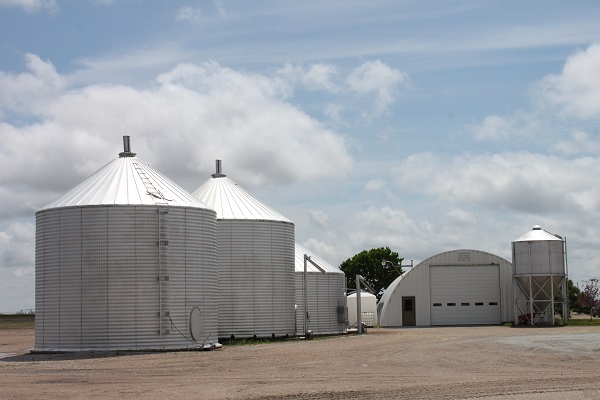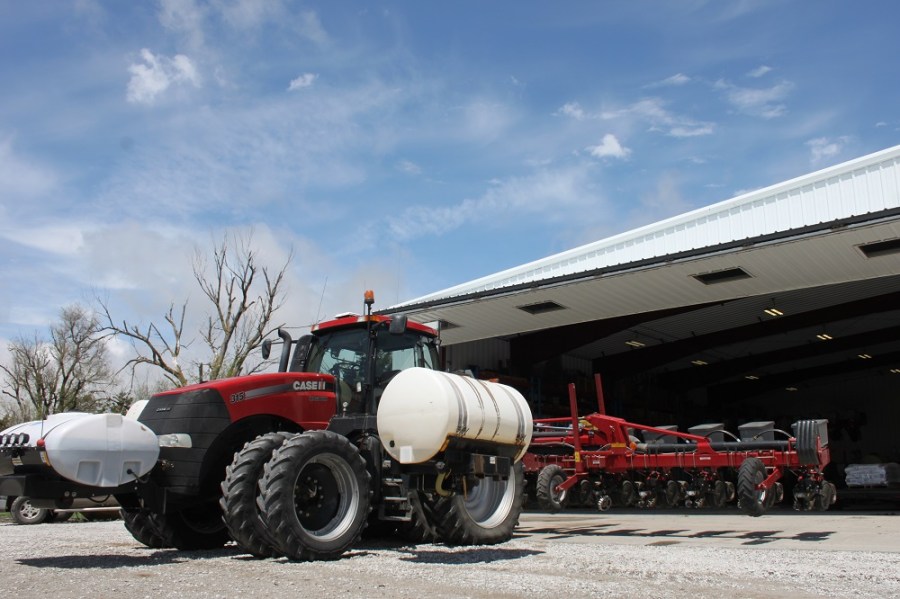American farmers have considerable experience dealing with issues increasingly prevalent here: soil erosion, water shortages and quality, nutrient retention. Courtesy of Case IH, CPM visited a Nebraska family farm business to discover how it tackles these and other issues.
Very little of this would be profitable and sustainable without the retention of soil and moisture that’s made possible by minimising soil movement
By Martin Rickatson
With average UK arable enterprise size continuing to expand, the numbers behind US combinable crop farm businesses nowadays bear closer comparison with their counterparts here. Beyond the acreages concerned, there’s now also often little to separate larger US and UK businesses when it comes to tractor power and combine capacity, for example.

Sitting above the groundwater reservoir, the Ogallala Aquifer, this is tapped into to irrigate the farm’s corn, soybean and occasional wheat crop.
Indeed, farmers from the Lincs or Cambs fens could feel quickly at home out in the American Midwest. Average rainfall levels aren’t far different, at around 600mm – although states such as Iowa average 1000mm as a comparison. The sandy/silty clay loams are similar in type, although they tend to be coarse-textured loess silt types and shallow in places. In the heart of the state, the soils of Merrick County range from silty clay to sand and gravel, and were deposited by the Platte River, resulting in a wide degree of variability and water-holding capacity. This can lead to challenges with maintaining nutrient levels, soil structure and drainage, resulting in water and salt accumulation and leaving soils prone to iron chlorosis in the soybean and corn crops that dominate the area’s production.
Conversely, it’s the shallow soil profile in some areas that reduces water-holding capacity, meaning that in the event of a spring/early summer dry spell the land has less of a moisture buffer, making water and nutrient management more of a challenge. The flatness of the land means drainage can in some areas be very poor, but in others can be excessive given the region’s shallow groundwater tables.
But it’s the collective scale, rather than that of individual businesses, that still sets the US apart. Feed crops dominate the Midwest, and if it was a standalone state, Nebraska would rank third globally in terms of corn/maize-producing nations. The key to its productivity is not just the scale, soils and reasonable average rainfall, but the fact that precipitation can be easily supplemented by irrigation. The entire central and west-central area – almost two-thirds of the state – sits above a massive natural groundwater reservoir, the Ogallala Aquifer, and via irrigation permits the state’s farmers are able to tap into this, transporting water across a network of natural and man-made waterways throughout the Platte River Valley. As a result, land prices in the area are higher than in some less well-endowed areas of the state – and indeed the country – at around $5000/ac (£3795ac/£9377ha).
This is where Evan and Roxanne Brandes, whose family business trades as Brandes and Sons, farm seed and commercial corn (maize), soybeans and wheat with their daughter Carly and her husband Jeff Johnson, plus their other daughter Cortney and her husband Beau Bearnes. Evan’s brother Roger and his wife Sharon, plus their son Kane and his wife Julie, are also partners in the ten-person family business, with all having individual business responsibilities in the arable and livestock operation, as well as off-farm interests. A younger son from each side of the family is also involved.
For a number of previous generations the family operated gravity irrigation systems fed by open ditches, using conventional tillage to form ridges for directing and retaining water. However, having identified issues with physical structure, the 1960s saw the business begin to adopt minimum tillage practices to build organic matter levels and enhance retention of moisture and soil. A little later, the introduction of centre-pivot irrigator technology in the 1970s saw the family combine this with the adoption of ridge-till – similar to strip-till – in the 1980s to reduce trafficked area and tillage requirements, cultivating between rows for weed control.
“We now run a total of 45 pivot irrigators, all of which today are fitted with the technology that allows them to be operated via smartphone for precise scheduling, and we’re able to irrigate 99% of our cropping,” explains Jeff.
“Not only does this mean we have the ability to supply water to almost all areas of our land, but we can also utilise the same irrigation equipment for liquid fertiliser application, resulting in further reductions in field traffic as well as labour requirements.”
When glyphosate-tolerant corn/maize became available in 1997, the family used the opportunity to switch to full no-till corn establishment, and four years later was establishing all of its commercial corn this way (seed corn is also grown for Pioneer), retaining surface residue to prevent soil and moisture loss. While a conventional rowcrop planter worked well when drilling corn into soybean trash, planting soybeans into cornstalk stubble was a little more challenging, notes Evan.
“In 2005 we stopped shredding our cornstalks before planting, instead sowing soybeans each side of the old cornstalk stubble rows. Now when we plant corn, we use row cleaners ahead of each of the seed units to clear soybean trash from the path of the coulter so it isn’t hairpinned into the slot with the seed and allowed to affect seed-to-soil contact.
“In fields where seed corn is grown, ridge-till still provides the best weed control method, as we obviously can’t use glyphosate, and we can benefit from also being able to apply nitrogen when cultivating for weed control.”
While there’s a focus on extracting maximum value from rainfall and applied water, the family is also dedicated to maximising the efficiency of applied and existing nutrients, not only to get the most out of crop performance but also to protect local drinking water quality by minimising leaching risk. Grown as a corn/bean break crop every other year, wheat’s role in the rotation is largely to help here by scavenging residual nitrates from seed corn production, with soybeans planted directly between the wheat rows when the latter flowers in spring.
“This keeps nitrogen in the growing cycle and reduces the chance of it leaching into groundwater. Where wheat doesn’t follow corn, we use turnips as a cover crop to scavenge nitrates, establishing them once the male corn rows are cut out of seed corn fields.”
The business also runs a suckler cow herd, enabling good use to be made of the stubble turnips at the end of their season.
“We’ve tried oilseed rape and rye as cover crops, but the seed is quite a bit more expensive, and we didn’t see any additional advantage from using them.”
One of the key benefits the Brandes family business has seen over the course of its gradual move to no-till has been increased water-holding capacity of the soil, with both rainfall and irrigation water reckoned to be penetrating the soil more thoroughly in fields where no-till is used.
“Water is clearly soaking into the soil and recharging the water table, which is fairly shallow,” says Evan.
“The only place we may see a degree of water ponding is in the wheel tracks of the centre-pivot irrigators, which shows the difference between trafficked and untrafficked land. No-till practices help keep water in the soil profile, retaining it for later in the season, and encouraging deeper plant rooting, while reducing irrigation demand. In the fields where we still use gravity irrigation, you almost need the added compaction and tillage to make the irrigation furrows operate correctly, and here the cover crops aid nitrogen control and break up some of the compaction.”
The benefits of no-till are clearly more pronounced in seasons where rainfall is below average, he suggests.
“We’ve seen that previously, in years when we planted in drier soil and then had good spring rains, resulting in clearly improved plant stands. With no-till, we always have adequate soil moisture retained through into the spring, so getting a good stand isn’t such an issue and yields are more consistent. Soil structure is also maintained, improving infiltration, and increasing water-holding capacity for later in the year when rainfall is lower and the water is required.”
The family has further improved soil structure by using RTK technology and Case IH’s Rowtrac version of its Quadtrac 400 articulated tracked tractor, with 610mm (24in)-wide tracks spaced at 3m (120in), to minimise trafficked areas. The business’s main wheeled tractors, all Case IH Magnum models, are run on wide-spaced, narrow-profile dual wheels for the same reason.
“As we are using the articulated Rowtrac to work wide and shallow rather than deep, we can get sufficient power to the ground from narrow tracks,” says Jeff.
“With articulated steering and this narrow track width, plus the use of RTK signal technology for auto-steering, the Rowtrac version of the Quadtrac enables us to keep within the crop rows, limiting damage to both the soil and the crop.
“Coupled with running front track units on our 9230 Axial-Flow combines, this helps to complement our other measures aimed at soil, moisture and nutrient retention.”
With a rotation based primarily on corn and beans, July and much of Aug are preparation months rather than harvest ones, and seed corn is the first crop to be harvested, in early Sept, followed by soybeans before finishing up with commercial corn. Bean yield target is 100 bushels/acre, while for corn the figure is double that. At a specific weight of around 60lbs/bushel, that soybean yield equates to around 6.7t/ha. For corn, a specific weight of 56lbs/bushel means the weight yield equivalent is approximately 12.3t/ha.
“In addition to all having work interests outside the farm, one of the other ways in which we have been able to expand the business and accommodate more family members is by contract farming for others,” Jeff explains.
“We’re now working on this basis for a number of neighbouring farmers, under a deal whereby they retain 40% of the yield by volume, and are responsible for all input costs.
“But very little of this would be profitable and sustainable without the retention of soil and moisture that’s made possible by minimising soil movement, trafficking and compaction, enabling us to obtain the yields we do.
“We’re lucky enough to sit above a hugely beneficial natural resource in the Ogallala, and the responsibility of using just the right amount of water to maximise yields, keep our energy costs to a minimum, minimise nitrate leaching and try to preserve and maintain the aquifer is something we take very seriously.”
FARM FACTS
Brandes and Sons, Central City, Merrick County, Nebraska, USA
- Area farmed: 2200ha – part owned by various family members, part contract-farmed
- Farm partners: Evan and Roxanne Brandes, Roger and Sharon Brandes, Kane and Julie Brandes, Jeff and Carly Johnson, Beau and Cortney Bearnes, Alex Brandes, Jess Brandes
- Additional labour: Two full-time, two part-time
- Annual rainfall: 610mm – almost all land also irrigated
- Cropping: 880ha seed maize, 480ha commercial maize, 840ha soybeans, plus wheat in some years
- Livestock: 200-head suckler cow herd
- Soils: Loess-type silty clay loam
- Tractors: Case IH Steiger Rowtrac 400, Magnum 335, Magnum 315 x2, 7230, plus IH 1066 and Farmall 450 plus 300 for light yard duties
- Harvesters: 2x Case IH Axial-Flow 9230 with 12m grain/bean heads and 12-row corn heads; 2x Oxbo seed corn pickers
- Sprayer: 40m front-boomed Miller Nitro 5345 self-propelled
- Irrigators: 45 pivot-type, also used to distribute liquid fertiliser
- Planters: 24-row Monosem, 18-row Case IH




